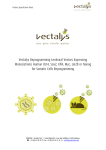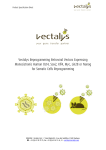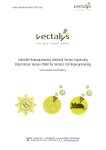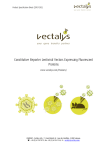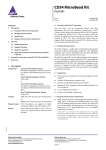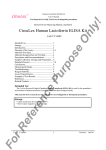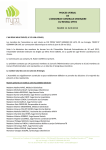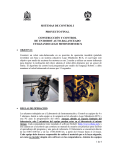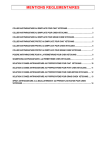Download Constitutive Reprogramming Lentiviral Vectors
Transcript
Product Specification Sheet (20131203) Constitutive Reprogramming Lentiviral Vectors Expressing Polycistronic Human OSKM or Monocistronic Human Oct4, Sox2, Klf4, Myc, Lin28 or Nanog for Somatic Cell Reprogramming www.vectalys.com/Products/ COMPANY : Vectalys SAS, Canal Biotech II, 3 rue des Satellites, 31400 Toulouse. : +33 (5) 61 28 70 75, fax: +33 (5) 62 26 12 44, : [email protected] Product Specification Sheet (20131203) Constitutive Reprogramming Lentiviral Vectors Catalog Number referring to this User Manual: 0001VCT; 0002VCT; 0003VCT; 0004VCT; 0005VCT; 0006VCT; 0007VCT Contents: Cat.# 0001VCT: 3x20µl of Oct4, Sox2, KLF4, and Myc polycistronic lentiviral vectors. Cat.# 0002VCT: 3x20µl of Oct4 monocistronic lentiviral vectors. Cat.# 0003VCT: 3x20µl of Sox2 monocistronic lentiviral vectors. Cat.# 0004VCT: 3x20µl of KLF4 monocistronic lentiviral vectors. Cat.# 0005VCT: 3x20µl of cMyc monocistronic lentiviral vectors. Cat.# 0006VCT: 3x20µl of Lin28 monocistronic lentiviral vectors. Cat.# 0007VCT: 3x20µl of Nanog monocistronic lentiviral vectors. Please refer to the Certificate of Analysis (CoA) for the titer of your particular lot. Product Description: The Vectalys Constitutive Reprogramming Lentiviral Vectors are prepackaged lentiviral particles expressing either polycistronic Oct4, Sox2, KLF4, and Myc or individual Oct4, Sox2, KLF4, Myc, Lin28 or Nanog for reprogramming human somatic cells. These VSV-G pseudotyped viruses are capable of infecting both dividing and non-dividing cells. The high purification level of these lentiviral particles allows transduction of primary cells and immortalized cell lines without inducing any toxicity to the cells, even at high multiplicity of infection (M.O.I.). The expression of these six factors has been shown to reprogram a variety of differentiated cells into induced pluripotent stem (iPS) cells with embryonic stem (ES) cell-like properties. Handling and Storage : Store at -80°C. Keep frozen until use. Avoid repeated freezing and thawing. The use of gloves and disposable lab coats while working with viral derived vectors is strongly recommended. This product must only be handled in a biosafety cabinet under BSL-2 conditions. Lentiviral vectors are stable for at least 1 year after receipt when stored at -80°C. After thawing, immediately place on ice (please refer to the thawing protocol included in this document). The viral vectors are packaged in working aliquots and can be thawed just before use. In the case that more than one freeze-thaw cycle is required according to your application, Vectalys recommends to expect a decrease of about 15-20% in viral vector titer for each freeze-thaw cycles. This product is distributed for research use only. It is not for use in diagnostic procedures as the safety and efficacy of this product in diagnostic or other clinical uses has not been established. The use of lentiviral derived vectors requires you to follow laboratory biosafety procedures and practices in agreement with your country regulations. SYMBOL : CLASSIFICATION : Biorisk class C2L2 COMPANY : Vectalys SAS, Canal Biotech II, 3 rue des Satellites, 31400 Toulouse. : +33 (5) 61 28 70 75, fax: +33 (5) 62 26 12 44, : [email protected] Product Specification Sheet (20131203) Safety precautions: The greatest safety risk associated with viral delivery systems comes from the potential generation of recombinant viruses that are capable of autonomous replication during the packaging process. The Vectalys Reprogramming Lentivirus platform eliminates these hazards by combining a disabled viral genome with a unique manufacturing process. Also, the viral genes that facilitate the enclosing of the sequence in a viral capsid (e.g., Gag, Pol, Env) are distributed on multiple helper plasmids (which do not contain significant regions of homology) during packaging. This strategy further minimizes the probability of recombination events that might otherwise generate viruses capable of autonomous replication. With these safety measures, the Vectalys Reprogramming Lentivirus particles can be used in standard Biosafety Level 2 tissue culture facilities and should be treated with the same level of caution as any other potentially infectious agent. Also, please note that c-Myc and Klf4 proteins are reported to have oncogenic properties. Directions for use, thawing protocol: The vectors should be taken out of the -80°C freezer and placed on ice immediately prior to use. Thaw the vectors on ice. Once thawed, the vectors should be used for transduction as soon as possible to avoid degradation. 1- Just before transduction, remove the tubes of viral supernatant from the -80°C freezer and thaw them on ice at 4°C. 2- It is essential to avoid thermal shock to the cells and vectors. If the vectors will be diluted in medium, use medium that has been equilibrated to room temperature to minimize the heat shock to the vectors and the cells. 3- Five minutes before transduction, remove the tubes from ice and allow to warm to room temperature. In the case that more than one freeze-thaw cycle is required according to your application, expect a decrease of about 15-20% in viral vector titer for each freeze-thaw cycle. Directions for use, Materials Required but Not Provided: 1. 2. 3. 4. 5. 6-well plates (TC grade) Cell counter / hemocytometer Complete media, FBS supplemented Phosphate Buffered Saline (PBS) Polybrene® (Hexadimethrine bromide – Sigma: 107689-10G) Directions for use, Transduction Protocol for Human Somatic Cells: The following protocol has been optimized for early passage human foreskin fibroblasts. This protocol allowed us to transduce human foreskin fibroblast cells with a transduction efficiency of 100%. Use the following protocol as a reference to optimize conditions that will enable the generation of iPS cells from other human target cells. The pre-transduction seeding density and cell quantity to be transduced can be modified as necessary. The multiplicity of infection (M.O.I.), the time of viral vector incubation on cells and the Polybrene® concentration are critical points that must strictly be followed. Day 0: Cells seeding COMPANY : Vectalys SAS, Canal Biotech II, 3 rue des Satellites, 31400 Toulouse. : +33 (5) 61 28 70 75, fax: +33 (5) 62 26 12 44, : [email protected] Product Specification Sheet (20131203) Seed the cells by plating from 1x104 to 5x104 cells per well of a 6-well plate according to the cell type you are using. Use the same culture medium that is used to maintain target cells in a proliferative state. The maximum volume per well of a 6-well plate should be 4ml. Incubate overnight in a 37°C, 5% CO2 incubator. Be sure to include a control well for counting the number of cells on the day of transduction. Day1: Transduction A) Count the number of cells in the control well of the 6-well plate. The control well is used to determine the amount of viral vectors needed to achieve the target M.O.I. and to keep the M.O.I. constant from one experiment to another. B) Using the following equation, determine the volume of each viral vector required to achieve the advised M.O.I. of 5. Please pay attention to the lot titer as it may vary by lot: Viral vectors volume required (µl) = Number of cells seeded x M.O.I. x 1000 Viral Vectors Titer (TU/ml) C) Thaw the required amount of polycistronic OSKM or each individual monocistronic lentiviral vectors according to the thawing protocol provided above. Homogenize the viral supernatant by pipeting up and down and not by inverting the vial upside down. D) Prepare the transduction mix by adding the required volume of thawed viral particles to complete media containing 20µl of Polybrene® (800µg/ml). The final volume should be 4ml at maximum for transduction in a 6-well plate. E) Discard the medium from each well and add the transduction mix to the cells (be careful to apply the transduction mix to the well edges to avoid any cell disruption). Gently rock the plate from side to side to mix the viral vectors onto the target cells. F) Incubate the plate for 5h in a 37°C, 5% CO2 incubator. G) After the 5 hour incubation, discard the transduction mix and wash the cells once with 3ml 1x PBS per well. Then, discard the PBS and replace it with 4ml of complete media. H) If necessary, perform a second transduction by repeating the steps described above. A second transduction must not be performed before 48h after the first transduction. References: 1. 2. 3. 4. Rashid S. T, Corbineau S, Hannan N, Marciniak S.J, Miranda E, Alexander G, Huang-Doran I, Griffin J, Ahrlund-Richter L, Skepper J, Semple R, Weber A, Lomas D. A, Vallier L. Modeling inherited metabolic disorders of the liver using human induced pluripotent stem cells. J Clin Invest., 2010, 120 (9), 3127-3136. Lapillonne H, Kobari L, Mazurier C, Tropel P, Giarratana M-C, Zanella-Cleon I, Kiger L, Wattenhofer-Donze M, Puccio H, Hebert N, Francina A, Andreu G, Viville S, and Douay L. Red blood cells generation from human induced pluripotent stem cells: perspectives for transfusion medicine. Haematologica. 2010, 95 (10), 1651-1659. Banito A, Rashid ST, Acosta JC, Li S, Pereira CF, Geti I, Pinho S, Silva JC, Azuara V, Walsh M, Vallier L, Gil J. Senescence impairs successful reprogramming to pluripotent stem cells. Genes Dev., 2009, 23: 2134-2139. Vallier L, Touboul T, Brown S, Cho C, Bilican B, Alexander M, Cedervall J, Chandran S, Ährlund-Richter L, Weber A, Pedersen R.A. Signaling pathways controlling pluripotency and early cell fate decisions of human induced pluripotent stem cells. Stem cells, 2009, 27 (11) : 2655-2666. Quality controls: COMPANY : Vectalys SAS, Canal Biotech II, 3 rue des Satellites, 31400 Toulouse. : +33 (5) 61 28 70 75, fax: +33 (5) 62 26 12 44, : [email protected] Product Specification Sheet (20131203) The several different quality controls are applied to the Vectalys Reprogramming Lentiviral Vectors: The viral vectors are tittered in efficient transduction units. Viral integration copy numbers are quantified by transduction of mammalian cells followed by qPCR of the genomic DNA. The viral vectors are also tittered as physical particles using an ELISA assay. The specific activities, according to DNA and proteins impurities, are measured. The residual DNA and total proteins are quantified using commercial kits. These controls are performed because Vectalys has demonstrated the impact of residual DNA and protein impurities on increasing cellular toxicity after transduction. Frequently Asked Questions What is the difference between transduction units (TU) and physical particles (PP)? During the production of viral vectors, functional and nonfunctional particles are produced. A functional and complete particle is called a transduction unit (TU). Physical Particles (PP) represents functional particles and also empty particles, damaged particles and free p24 protein (see figure below). The PP/TU ratio is a quality control measure of the quality of the vector product. It is optimal to remove as much PP in the viral supernatants to keep only the functional particles. It is therefore necessary to have reliable and discriminating titration methods for the different types of particles. Why use a titer expressed in TU / ml? A titer in TU/ml is required for accurate calculation of functional vectors applied to the cells. The TU/ml titer provided by Vectalys is a precise measure of only functional viral vectors. Calculating the volume of vectors from this type of titration is precise, and the experimental results can be extrapolated and compared from one experiment to another. Viral vectors volume required (µl) = Number of cells seeded x M.O.I. x 1000 Viral Vectors Titer (TU/ml) Titration of physical particles (PP) is often used in commercial kits by competitors because its ease of use. But the PP/ml titer provides an approximate titer of viral vectors because it represents a mixture of COMPANY : Vectalys SAS, Canal Biotech II, 3 rue des Satellites, 31400 Toulouse. : +33 (5) 61 28 70 75, fax: +33 (5) 62 26 12 44, : [email protected] Product Specification Sheet (20131203) functional and nonfunctional particles. Calculating the volume of vectors from this type of titration may distort the results. The key factor: normalization of viral vector titers using a reporter expressing vector as an internal standard The viral titer determined by Vectalys corresponds to the number of integrated genomes (qPCR) or transduction units (FACs) generated by transducing 1E5 HCT116 cells with 1ml of viral supernatant in our experimental conditions (3 days of cell culture after transduction with 8µg/ml of Polybrene). The results obtained by qPCR critically depend on the conditions of the titration experiment. It is therefore crucial to include standard controls with the samples to standardize the titers from one quantification experiment to another. This normalization method using an internal qPCR control in all titrations experiments allows the titers of vector batches to be comparable with each other. The internal control corresponds to viral vectors expressing reporters. The titer obtained from FACS experiments corresponds to the level of expression of the reporter proteins and may be considered as a functional titer. This result is used to correlate viral titers obtained by qPCR (biological titer) with viral titer obtained by FACS (functional titer). It is then possible to deduce the functional titer from the viral titer obtained by qPCR for any samples. FACS 0,0001 50 0,0010 0,0100 dilution 0,1000 0 1,0000 copies/cell GFP + cells % gated 100 QPCR 300 250 200 150 100 50 0 R² = 0,9901 0,0 0,2 dilution 0,4 0,6 Notice to purchaser: Purchaser represents and warrants that it will use the Vectalys Constitutive Reprogramming Lentiviral Vectors: Human OSKM purely for research purposes, not for diagnostic use, not for resale, and not for use in humans or veterinary applications. Vectalys will not be held responsible for patent infringement or other violations that may occur with the use of our products. Purchaser must determine the suitability of the product(s) for their particular use. Additional terms and conditions may apply. COMPANY : Vectalys SAS, Canal Biotech II, 3 rue des Satellites, 31400 Toulouse. : +33 (5) 61 28 70 75, fax: +33 (5) 62 26 12 44, : [email protected]






